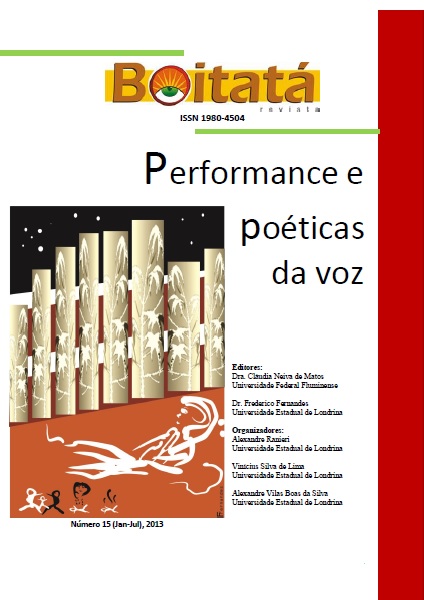The mind & the machine: performance, game design, and humanities
DOI:
https://doi.org/10.5433/boitata.2013v8.e31544Keywords:
Game design, TeachingAbstract
This article argues in favor of teaching video game design as a humanistic discipline. In The Art of Videogames (2009), Grant Tavinor defines video games as a form of fiction and art. Based on some of the ideas that Tavinor highlights, Chris Crawford’s standpoint on game designers’ preparation in Chris Crawford on Game Design (2003), and Huizinga’s description of the functions of play in Homo Ludens (1964), I will reason for the approach of housing the undergraduate game studies and design in the faculty of humanities as one discipline. The rationale of why the art and technology of games should meet in humanities emerges from the present state of games’ content in the mainstream games; that is, what they show and what they tell. This is of course a case for intellectual, enlightened, inspired, and thought-provoking game stories, and how this could be achieved in the humanities.
References
ATKINS, B. (2003). More than a game: The computer game as a fictional form. New York: Manchester UP.
BARTHES, R. (1975). An introduction to the structural analysis of narrative. L. Duisit (Trans.). In: New Literary History: A Journal of Theory and Interpretation 6.2, p.237- 272.
CRAWFORD, Chris Crawford on game design. Indianapolis: New Riders. Entertainment Software Association. Essential facts about the computer and vídeo game industry. Retrieved on November 21, 2011. http://www.theesa.com/facts/pdfs/ESA_EF_2011.pdf
GEROME, J-L. (Artist). Pollice verso [Painting]. Phoenix Art Museum, 1872
GOUGLAS, Sean; ROCCA, Jason Della; JENSON, Jennifer; KEE, Kevin; ROCKWELL, Geoffrey; SCHAEFFER, Jonathan; SIMON, Bart and WAKKARY, Ron. Computer games and Canada’s digital economy: The role of universities in promoting innovation. In: Report to the Social Science Humanities Research Council. Knowledge Synthesis Grants on Canada’s Digital Economy. 2010. Retrieved from http://grand-nce.ca/newsandmedia/news-container/2011/how-important-is-thevideo-game-industry-to-canada-extremely-important.-thats-why-you-should-read-thisreport.
HAND, R. J. Theatres of interactivity: Video games in the drama studio. In: GARRELTS, N. (Ed.) Digital gameplay: Essays on the nexus of game and gamer. Jefferson, North Carolina, and London: McFarland & Company, 2005. p.208- 220
HUIZINGA, J. Homo ludens: A study of the play-element in culture. Boston: Beacon Press, 1964.
JAHN, M. Narratology: A guide to the theory of narrative. Version 1.8. English Department, University of Cologne, 2005. Retrieved on from http://www.unikoeln.de/~ame02/pppn.htm
LAUREL, B. Computers as theatre. Boston: Addison-Wesley Publishing, 1993
NEWMAN, J. Videogames. London and New York: Routledge, 2004.
PEARCE, C. Towards a game theory of game. In: WARDRIP-FRUIN, N.; HARRINGTON, P. (Eds.). First person: New media as story, performance, and game. Cambridge, MA: MIT Press, 2004. p.143-153.
PERRY, D. Are Games Better Than Life? [Ted TV Lecture]. Retrieved from http://www.ted.com/talks/david_perry_on_videogames.html.
Tavinor, G. The art of videogames. Malden, MA: Wiley Blackwell, 2009
WHITLOCK, K. Beyond linear narrative: Augusto Boal enters Norrah. In: GARRELTS, N. (Ed.). Digital gameplay: essays on the nexus of game and gamer. London: McFarland, 2005, p.189-207.
Downloads
Published
How to Cite
Issue
Section
License
Copyright (c) 2013 Boitatá

This work is licensed under a Creative Commons Attribution 4.0 International License.
Boitatá esta licenciada com CC BY sob essa licença é possível: Compartilhar - copiar e redistribuir o material em qualquer suporte ou formato. Adaptar - remixar, transformar, e criar a partir do material, atribuindo o devido crédito e prover um link para a licença e indicar se mudanças foram feitas.




















